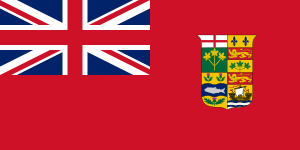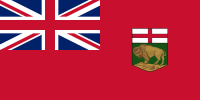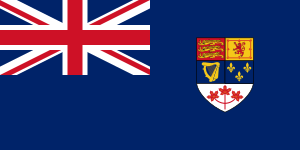Canadian Red Ensign facts for kids
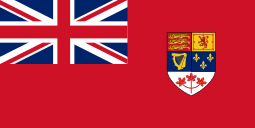 |
|
| Name | Red Ensign |
|---|---|
| Use | Civil ensign |
| Proportion | 1:2 |
| Adopted | 1957 (earlier versions in 1892 and 1922) |
| Relinquished | 1965 |
| Design | A red field, featuring the Royal Union Flag in the canton, defaced with the shield portion of the coat of arms of Canada. |
The Canadian Red Ensign (in French, Enseigne Rouge Canadienne) was an important flag for Canada for many years. It was used from 1892 to 1965 as a flag for ships and later became the unofficial national flag of Canada before 1965. This flag is a type of British Red Ensign. It has the Royal Union Flag (also known as the Union Jack) in the top left corner. The main part of the flag shows the shield from the coat of arms of Canada.
The Canadian Red Ensign started as an informal flag around the 1870s. People used it on ships and public buildings. In 1892, it officially became the flag for Canadian ships. At first, it showed the coats of arms of the Canadian provinces. But in 1922, the official Canadian coat of arms replaced these provincial symbols. During the Second World War, the Red Ensign was a strong symbol for Canada's armed forces. In 1945, the government said it was a "distinctive Canadian flag" for government buildings. However, it was never made the official national flag. That role belonged to the Union Flag until the Maple Leaf flag was adopted in 1965. The Maple Leaf flag then took over as Canada's main flag for both land and sea.
Contents
What Does the Canadian Red Ensign Look Like?
The Canadian Red Ensign is based on the Red Ensign of the United Kingdom. It has the Arms of Canada as a shield in the bottom right part of the flag. This shield is divided into four sections. These sections show the coats of arms of England, Scotland, Ireland, and the Kingdom of France. These four nations were important in Canada's early history. The first three sections are the same as the Arms of the United Kingdom. At the bottom of the shield, there is a branch with three maple leaves. These leaves represent Canada. They are shown in their natural autumn colours: red and gold. An older version of the flag, used from 1922 to 1957, had green maple leaves.
How Did the Canadian Red Ensign Develop?
Canadians began using the Red Ensign with a Canadian symbol as early as 1868. This was soon after Canadian Confederation, when Canada became a country. It was used unofficially on land and at sea. Canada's first Prime Minister, Sir John A. Macdonald, encouraged its use. In 1892, the British Admiralty officially allowed it for ships registered in Canada. This rule was put into the Canada Shipping Act in 1934. However, the flag was not legally recognized for use on land. The Royal Union Flag was still Canada's official national flag until 1965.
Despite not being official on land, the Red Ensign was widely used. It flew over the Parliament Buildings until 1904, when the Union Flag replaced it. Different versions of the Red Ensign continued to be flown. It was very visible in patriotic events and during efforts to recruit soldiers in the First World War. You can see it in many old photos of Canadian soldiers and in victory parades.
The first Canadian Red Ensign had the arms of the four original provinces on its shield. However, flag makers often added extra designs like wreaths or crowns. There was no single standard design for the Red Ensign until the early 1920s. In 1921, the Canadian government asked King George V to create a new coat of arms for Canada. The College of Arms designed this new coat of arms. The new shield was officially added to the Canadian Red Ensign on April 26, 1922.
In 1924, the Red Ensign was approved for use on Canadian government buildings outside Canada. The flag became even more official on September 5, 1945. The Governor General of Canada signed an order that said the Red Ensign with the Coat of Arms shield could be flown from Canadian federal government buildings. This meant it could be used both inside and outside Canada as a "distinctive Canadian flag." It once again flew over Parliament.
The Red Ensign was Canada's civil ensign (flag for ships) from 1892 to 1965. Then, the Maple Leaf flag replaced it. From 1922 to 1957, the Canadian Red Ensign looked almost the same. The only differences were that the maple leaves in the coat of arms were green, and the Irish harp looked slightly different. A blue ensign, which also had the Canadian coat of arms, was used by the Royal Canadian Navy until 1965.
In 2007, the Canadian Red Ensign was officially recognized as a "national symbol of Canada." This recognition came from the Public Register of Arms, Flags and Badges of Canada.
The Vimy Ridge Red Ensign
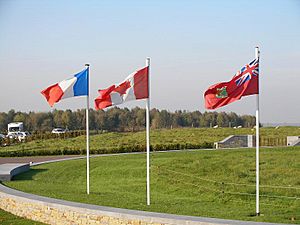
A special Red Ensign was carried by the 5th Canadian Infantry Battalion at the Battle of Vimy Ridge in 1917. This flag still exists today and might be the oldest Canadian flag. The Battle of Vimy Ridge was very important. It was the first time all four divisions of the Canadian Expeditionary Force fought together in the First World War. Many see it as a key moment in Canada's history and national identity.
The Red Ensign flown at Vimy Ridge in 1917 had the arms of Canada's first four provinces. After the battle, a soldier named Lieutenant-Colonel Lorn Paulet Owen Tudor gave the flag to the Imperial War Museum in the United Kingdom.
For many years, the Imperial War Museum did not want to send the flag back to Canada. They even refused a request in 2000 for a ceremony about Canada's Tomb of the Unknown Soldier. A museum official called the flag "our most important First World War Commonwealth artifact."
Eventually, after long talks, the Imperial War Museum agreed to lend the flag to Canada. This was for the opening of the new Canadian War Museum in Ottawa in 2005. The flag was returned to the United Kingdom in 2008.
There is another Red Ensign that is said to have been carried by Canadian troops at Vimy Ridge. It is kept at the Penticton Museum and Archives in Penticton, British Columbia. This flag is a simple red ensign, without a coat of arms.
How Is the Canadian Red Ensign Used Today?
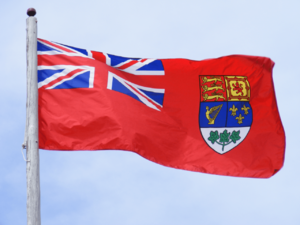
Even though the Maple Leaf flag is much more common, different versions of the Canadian Red Ensign are still flown today. Because it was used by the Canadian Army during the world wars, it is flown alongside the Maple Leaf flag at many war memorials. This includes the Canadian National Vimy Memorial in France. Veterans' groups also use it. It is part of the official flag display for the Royal Canadian Legion. Sometimes, the flag is flown on old ships and at historical sites where it fits the time period.
In recent years, some groups have used the Red Ensign in ways that do not reflect its history. This has caused concern among groups like the Royal Canadian Legion. They believe that using the flag in such ways is wrong. They say it disrespects the flag's important and mainstream role in Canadian history.
Different Looks of the Canadian Red Ensign
Before the Red Ensign design became standard in 1922, flag makers often changed the badge. They made it larger each time a new province joined Confederation. This led to many unofficial flags being used.
At the opening ceremony of the 1936 Summer Olympics, a version of the 1922–1957 Red Ensign was carried by Canadian Olympian James Worrall. This flag had the arms inside a white circle. However, the regular Red Ensign without the circle was flown with other national flags around the stadium.
Some of the different versions are shown below.
-
 1868: The Canadian Red Ensign used at July 1 Dominion Day celebrations in Barkerville, BC. Canada did not have an official flag yet.
1868: The Canadian Red Ensign used at July 1 Dominion Day celebrations in Barkerville, BC. Canada did not have an official flag yet. -
 1870: An early version of Manitoba's coat of arms was added for the new province.
1870: An early version of Manitoba's coat of arms was added for the new province. -
 1873: The flag changed to include British Columbia and Prince Edward Island. The badge was always on a white disk in this version.
1873: The flag changed to include British Columbia and Prince Edward Island. The badge was always on a white disk in this version. -
 1896: British Columbia adopted a new coat of arms.
1896: British Columbia adopted a new coat of arms. -
 1907: Alberta and Saskatchewan were added to the flag. The coats of arms of British Columbia, Prince Edward Island, and Manitoba took on their modern forms.
1907: Alberta and Saskatchewan were added to the flag. The coats of arms of British Columbia, Prince Edward Island, and Manitoba took on their modern forms.
Provincial Flags Based on the Red Ensign
Today, two Canadian provincial flags are Red Ensigns. These are the flag of Ontario and the flag of Manitoba. In 1965, after a big debate about the national flag, the Maple Leaf flag was chosen. However, many people still liked the Red Ensign. Because of this, Ontario and Manitoba adopted their provincial flags in 1965 and 1966, respectively. These flags kept the Red Ensign design.
The Canadian Blue Ensign
The Canadian Blue Ensign is similar to the Red Ensign. This flag was used by the Royal Canadian Navy from its beginning until the Maple Leaf flag was adopted in 1965. The British Admiralty approved the Blue Ensign in 1868 for ships owned by the Canadian government. It was used as a special flag for ships when they were anchored or moving slowly.
In 1937, the Canadian Government decided that the Canadian Blue Ensign would be used by several Canadian yacht clubs. Before this, these clubs used the British Blue Ensign. This continued until the Maple Leaf flag was introduced in 1965. Today, some Canadian yacht clubs still use the Canadian Blue Ensign to remember this history.


